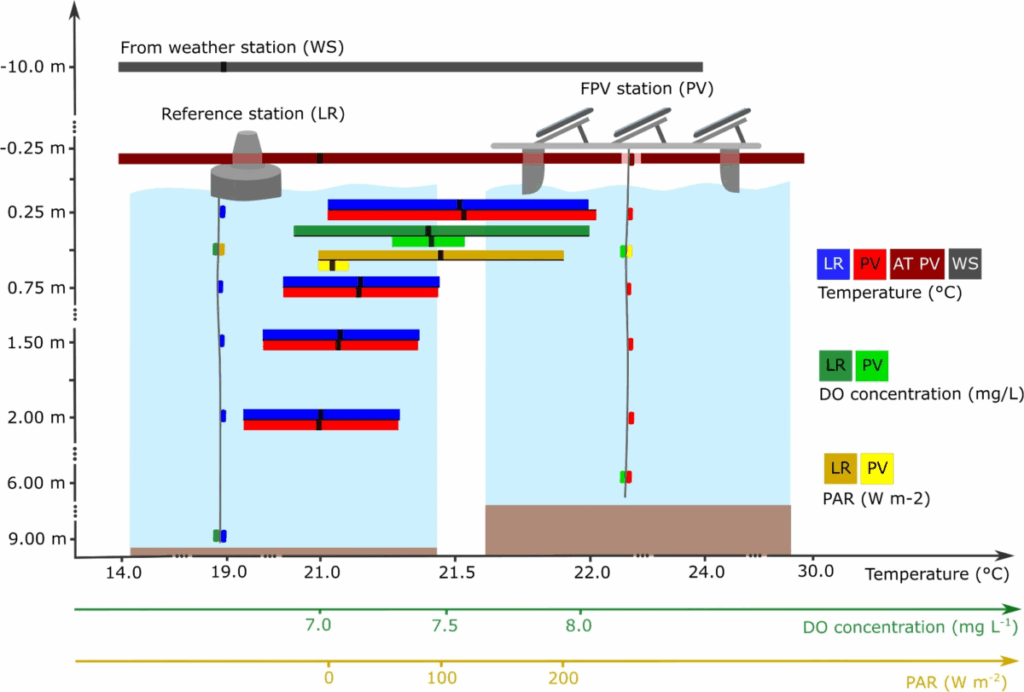Researchers in Brazil have installed a vertical thermistorical chain with six temperature loggers under a floating PV factory and on a nearby reference. The system also registered solved oxygen and photosynthetically active radiation to assess the environmental effects.
Research led by scientists from the Brazilian Federal University of Paraná (UFPR) carried out a field rating of temperature variations, dissolved oxygen (DO) and photosynthetically active radiation (par) in a floating PV system. They used a vertical thermist scenery of six temperature loggers that were installed under the floating solar installation.
“Our study is the first to perform long -term measurements with high -frequency sensors,” said researcher Tobias Blenderer PV -Magazine. “Moreover, it covers more information about the water column, while other studies only measured on the surface. It also contains measurements of the air temperature between the panels and the water surface, which indicates a strong heating effect as a result of raised panel temperatures.”
The team registered data from October 2022 to February 2024, with intervals of one minute. The floating PV factory was installed on a drinking water reservoir in the south of Brazil. The system covered approximately 0.02% of the surface of the reservoir and consisted of 396 polycrystalline silicon panels, each with a capacity of 330 W, ranked in 22 strings of 18 modules.
“The climate is characterized by moderate conditions without a dry season and a warm summer,” the researchers said. “The average temperature varies from 5.8 ° C to 33.8 C. Annual precipitation in the region varies between 1,400 mm and 1,600 mm. The area is dominated by daily southeastern winds, with an average of 1,52 m/s. Wind events of more than 2.00 m/s are rare and is typically insulated conditions.”
Thermistoren were used on depths of 0.25 m, 0.75 m, 1.50 m and 2.00 m, while Do and Parsensoren were installed on 0.5 m and 6 m. A reference station (LR) was placed in open water, with temperature loggers at 0.25 m, 0.75 m and 2.00 and 2.00 and SSORSor On the coast, 40 m of the floating PV series, measured relative humidity, air temperature, shortwave radiation, wind direction and wind speed.
“Our results show a shift in heating and cooling periods, in contrast to the binary findings from earlier literature, where the heating or cooling of the surface water temperature is reported,” BlenGeler said. “The panels indeed block radiation (so heating) in the early morning periods, so that the water is heated more slowly, compared to a reference point. During the day, during the day, when the panel temperatures become high, the heating of the water surface is the dominant factor in the late afternoon.
Blenveringer added that Do -Measurements showed a reduction in wind jugs for reduced oxygen concentrations under the panels. He said that par was considerably higher on the LR station than on the PV site, with the reduction of par under the floating PV measured at 94.7%.
“Although the temperature differences include the uncertainty range of the sensors, some consistent trends were observed: at 0.25 m, a higher temperature trend on the PV station, which was about 6% higher than on the LR station; the PSD also showed a higher energy, although small, the results.” “At 0.50 m, the temperature pattern was comparable to that at a depth of 0.25 m, with reduced effects. For larger depths, the water temperature was consistently higher on the LR station, increasing with depth. This effect suggests the shadow effect of the FPV, which reduces the entry of solar radiation into the water column.”
The findings were published in “High frequency -monitoring for impact assessment of temperature, oxygen and radiation in floating photovoltaic system“In Scientific reports. The study was conducted by researchers from UFPR and Paraná State Water and Sanitation Company (Sanepar).
Image: Federal University of Paraná-Enpr, Scientific reports, CC by 4.0
This content is protected by copyright and may not be reused. If you want to work with us and reuse part of our content, please contact: editors@pv-magazine.com.
Popular content


